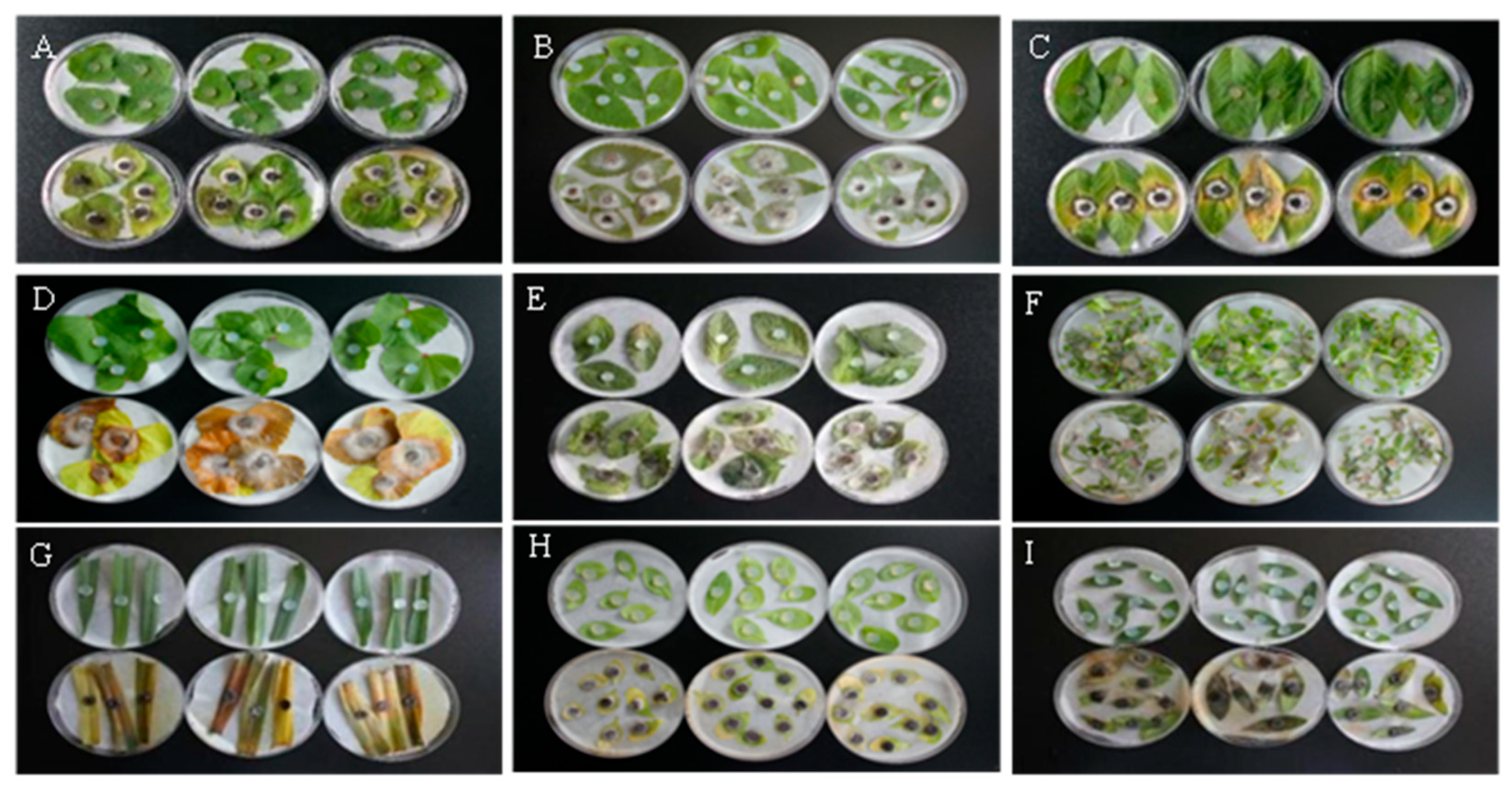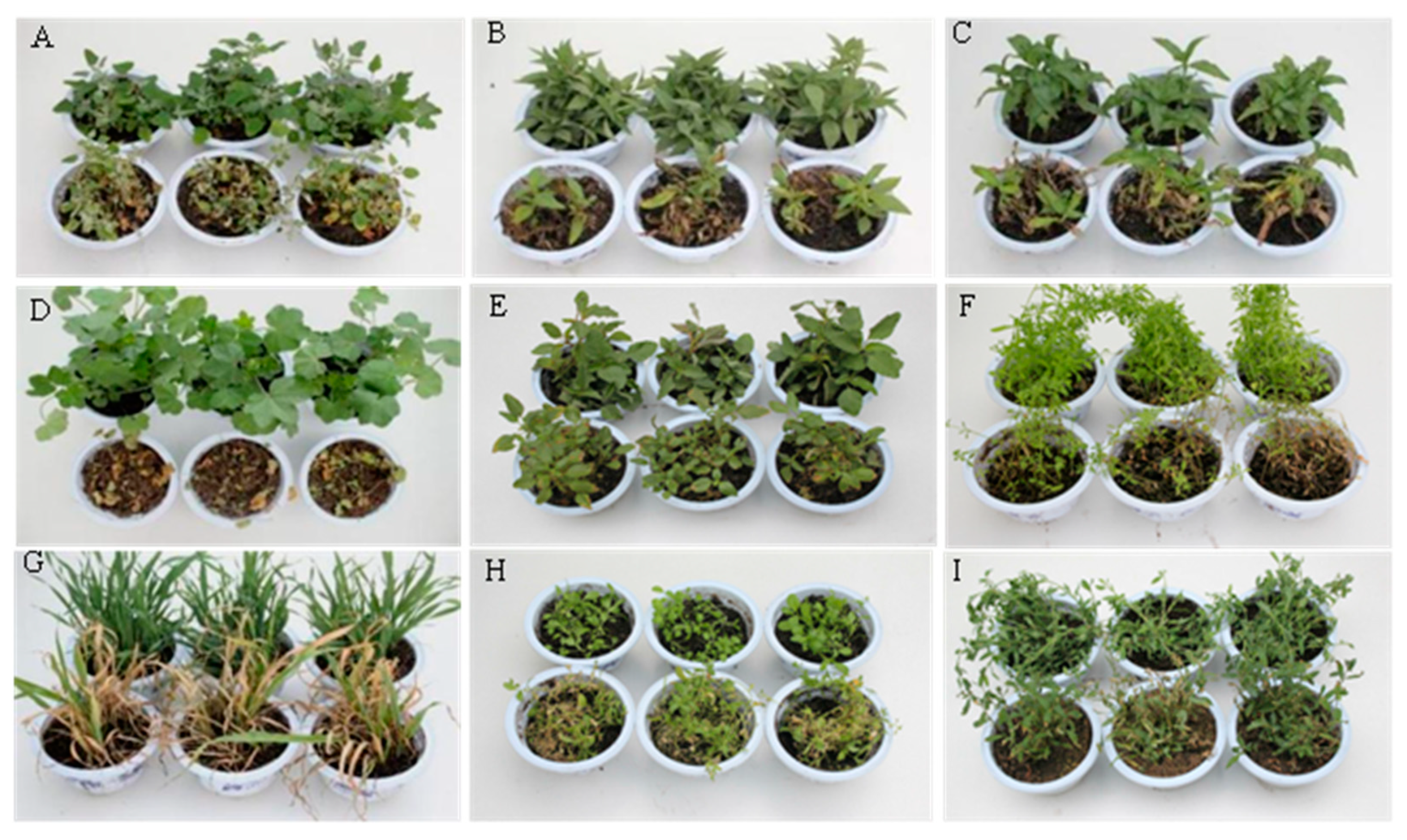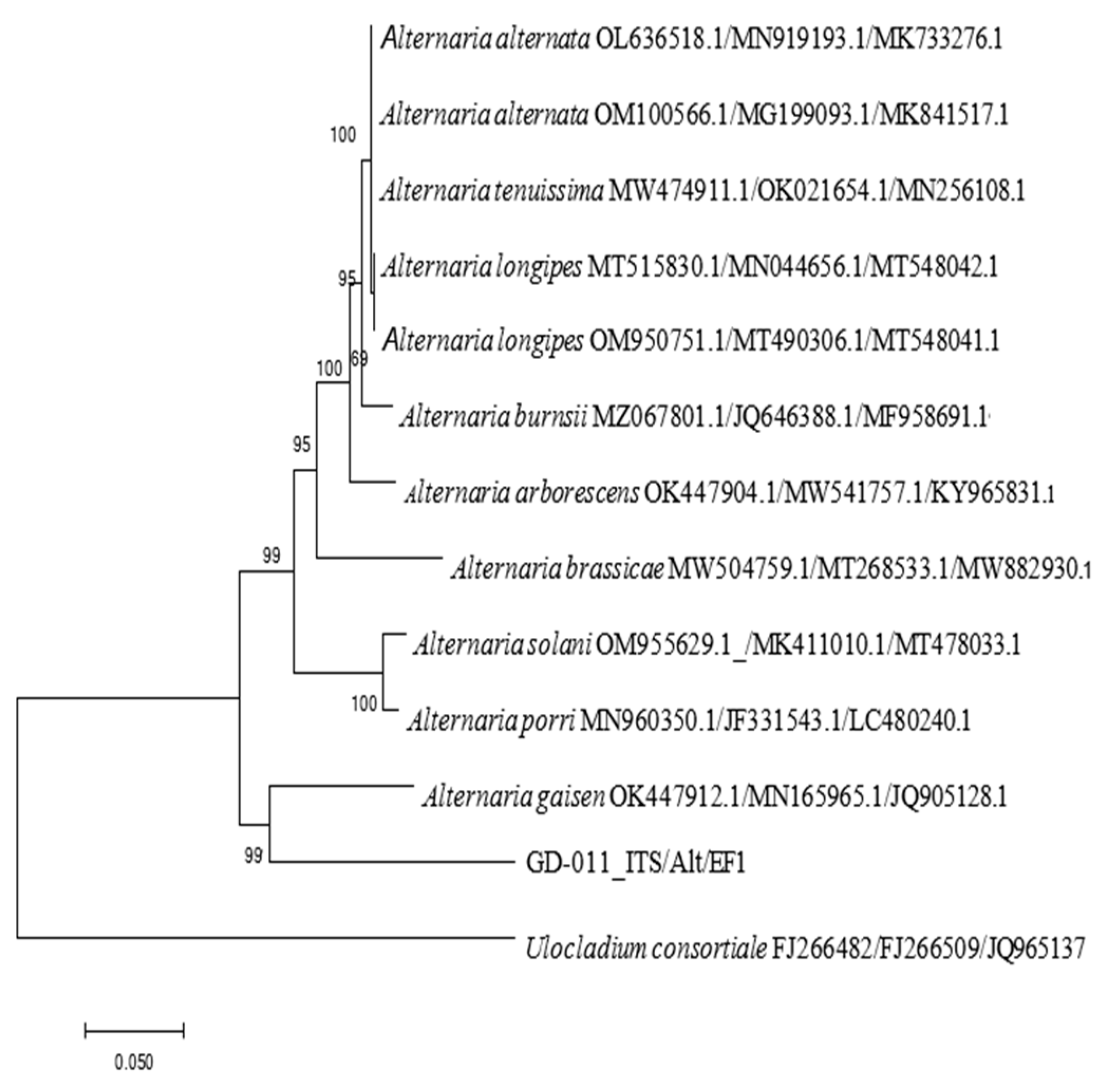Exploring the Biocontrol Potential of Fungus Alternaria gaisen GD-011 in the Tibetan Plateau
Abstract
1. Introduction
2. Materials and Methods
2.1. Test Strain
2.2. Test Weeds and Crops
2.3. Test Design and Method
2.3.1. Pathogenicity of Biocontrol Strain GD-011 to Weed Leaves
2.3.2. Pathogenicity of Biocontrol Strain GD-011 to Potted Weeds and Crop Safety Pathogenicity to Potted Weeds
Crop Safety
2.3.3. Identification of Biocontrol Strain GD-011
Morphological Identification
Molecular Identification and Phylogenetic Tree Construction
Scanning Electron Microscopic Observations of the Infection Process of the Strain on E. densa Leaves
2.3.4. Statistical Analysis
3. Results
3.1. Pathogenicity of Alternaria Gaisen GD-011 to Weed Leaves
3.2. Pathogenicity of A. gaisen GD-011 to Potted Weeds
3.3. Safety of A. gaisen GD-011 for Crops
3.4. Morphological Identification of A. gaisen GD-011
3.5. Molecular Biological Identification of A. gaisen GD-011
3.6. Observations on the Pathogenic Process in E. densa by Strain GD-011
4. Discussion
5. Conclusions
Author Contributions
Funding
Data Availability Statement
Acknowledgments
Conflicts of Interest
References
- Dubey, P.K.; Jha, R.K.; Singh, V.P. Effectiveness of Different Weedicides on Weed Biomass, Nutrient Uptake and Yield of Rice. J. Krishi Vigyan 2013, 2, 19–22. [Google Scholar]
- Babar, M.A.; Khan, A.; Azam, S. Weeds in T. aestivum crop: Weed whole plants nutrient concentration and uptake under fertilizer application and irrigation frequencies. Pure Appl. Biol. 2019, 8, 1724–1735. [Google Scholar] [CrossRef]
- Al-Dulaimi, R.I.; Ismail, N.; Ibrahim, M.H. Responses of growth of lady’s fingers (Abelmoschus esculentus L. ) to different treatments methods of dairy wastewater. Ann. Agric. Environ. Med. 2014, 21, 42–48. [Google Scholar]
- Popp, J.; Pető, K.; Nagy, J. Pesticide productivity and food security. A review. Agron. Sustain. 2013, 33, 243–255. [Google Scholar] [CrossRef]
- Green, J.M.; Owen, M. Herbicide-Resistant Crops: Utilities and Limitations for Herbicide-Resistant Weed Management. J. Agric. Food Chem. 2011, 59, 5819–5829. [Google Scholar] [CrossRef] [PubMed]
- Triolet, M.; Guillemin, J.; Andre, O. Fungal-based bioherbicides for weed control: A myth or a reality. Weed Res. 2020, 60, 12389. [Google Scholar] [CrossRef]
- Wang, L.; Zhu, C.H. Research progress in biological herbicides. Guangxi Trop. Agric. 2008, 01, 15–17. [Google Scholar]
- Qi, G.F.; Yang, B.; Ye, J.R. Research progress on plant pathogenic fungal toxins. J. Nanjing For. Univ. (Nat. Sci. Ed.) 2000, 24, 66–70. [Google Scholar]
- Li, D.Y. Preparation of Compound Microbial Inoculum and Its Application in the Control of Weeds in Wheat Field; University of Science and Technology: Anshan, China, 2020. [Google Scholar]
- Boyette, C.D.; Hoagland, R.E.; Abbas, H.K. Evaluation of the bioherbicide Myrothecium verrucaria for weed control in tomato (Lycopersicon esculenturn). Biol. Sci. Technol. 2007, 17, 171–178. [Google Scholar] [CrossRef]
- Maley, P.S.; Shebayan, J.A.Y. Field assessment of Fusarium oxysporum based mycoherbicide for control of Striga hermonthica in Nigeria. Biol. Control 2005, 50, 389–399. [Google Scholar]
- Liu, K.; Bai, L. An overview of research on microbial herbicide. Agric. Sci. Technol. 2013, 14, 1468–1470. [Google Scholar]
- Pinto, V.E.; Patriarca, A. Alternaria Species and Their Associated Mycotoxins. Methods Mol. Biol. 2017, 1542, 13–32. [Google Scholar] [PubMed]
- Ostry, V. Alternaria mycotoxins: An overview of chemical characterization, producers, toxicity, analysis and occurrence in foodstuffs. World Mycotoxin J. 2008, 1, 175–188. [Google Scholar] [CrossRef]
- Shi, J.; Zhang, M.; Gao, L. Tenuazonic Acid Triggered Cell Death Is the Essential Prerequisite for Alternaria alternata (Fr) Keissler to Infect Successfully Host Ageratina adenophora. Cells 2021, 10, 1010. [Google Scholar] [CrossRef] [PubMed]
- Palanichamy, P.; Kannan, S.; Murugan, D. Purification, crystallization and anticancer activity evaluation of the compound alternariol methyl ether from endophytic fungi Alternaria alternata. J. Appl. Microbiol. 2019, 27, 1468–1478. [Google Scholar] [CrossRef] [PubMed]
- Song, W.M. Weed Community Composition and Its Prevention and Control Countermeasures in Qinghai Oat Feld; Qinghai University: Xining, China, 2022; p. 000352. [Google Scholar]
- Suo, D.Z.; Zhang, R.J.; Tong, L.J. Refections on ecological protection and high-quality development of the yellow river source area. Qinghai Social. Sci. 2022, 5, 43–52. [Google Scholar]
- Wei, Y.H.; Guo, Q.Y.; Guo, L.Z.; Weng, H.; Cheng, L. The community composition and biodiversity of weeds in conservati on tillage system in Qinghai Province. Agric. Res. Arid Areas 2013, 31, 219–225. [Google Scholar]
- Fang, Z.D. Research Methods of Plant Diseases; China Agricultural Press: Beijing, China, 1998. [Google Scholar]
- Li, X.; Zhu, H.X. Isolation, identification and weed control potential of weed pathogenic strain GD-0221. J. Zhejiang Agric. 2022, 34, 1967–1975. [Google Scholar]
- Wu, J.L.; Wei, X.Y. Screening and identification of multifunctional endgentic strains for control of strawberry recropping disease. J. Shanxi Norm. Univ. (Nat. Sci. Ed.) 2021, 49, 105–111. [Google Scholar]
- Murray, M.G.; Thompson, W.F. Rapid isolation of high molecular weight plant DNA. Nucleic Acids Res. 1980, 8, 4321–4326. [Google Scholar] [CrossRef] [PubMed]
- Glass, N.L.; Donaldson, G.C. Development of primer sets designed for use with the PCR to amplify conserved genes from filamentous ascomycetes. Appl. Environ. Microbiol. 1995, 61, 1323–1330. [Google Scholar] [CrossRef] [PubMed]
- Wang, Y.B.; Ji, M.S.; Gu, Z.M. Development, research progress and future development ideas of biological herbicides. Pesticides 2019, 58, 86–88. [Google Scholar]
- Hong, S.G.; Cramer, R.A.; Lawrence, C.B. Alt a l allergen homologs from Alternaria and related taxa: Analysis of phylogenetic content and secondary structure. Fungal Genet. Biol. 2005, 42, 119–129. [Google Scholar] [CrossRef]
- Sun, Y.; Han, W.; Sun, Y.G. Pathogen identification and rDNA-ITS sequence analysis of cherry brown spot disease in Shandong Province. J. Agric. Sci. Technol. China 2017, 19, 44–49. [Google Scholar]
- Liu, Q.; Ning, N.N.; Ma, Y.Q. Isolation and identification of pathogen of cherry leaf spot in Qinghai Province. Plant Prot. 2020, 46, 48–55. [Google Scholar]






| Weed Species | Incidence Area/cm2 | Incidence Characteristics |
|---|---|---|
| Chenopodium album | 0.49 ± 0.25 | Leaf inoculation site produces a few gray mycelia, leaf yellowing, mycelia have penetrated the leaves |
| Elsholtzia densa | 2.45 ± 0.16 | Mycelium covering the entire leaf blade, leaf blade with chlorosis |
| Polygonum lapathifolium | 3.27 ± 0.33 | Leaves turn green and yellow, spots make the whole leaf wither and turn yellow-brown, leaf inoculation site covered with mycelium |
| Malva verticillata | 5.78 ± 0.25 | Spots appear first, then yellowing, and eventually the leaf color becomes yellowish brown, with numerous mycelia on the surface |
| Amaranthus retroflexus | 3.56 ± 0.71 | Produces dark brown irregular spots, mycelium makes the whole leaf yellow and wrinkled |
| Gallium aparine | 0.52 ± 0.08 | Gray mycelium production at the inoculation site, followed by leaf chlorosis |
| Avena fatua | 3.41 ± 0.18 | Leaves turn green and yellow |
| Weed Species | Incidence Rate/% | Disease Index | Fresh Weight Control Effect/% |
|---|---|---|---|
| C. album | 75.5 ± 2.37 b | 61.4 ± 3.14 c | 60.2 ± 2.65 bc |
| E. densa | 80.87 ± 2.38 ab | 81.87 ± 2.96 b | 83.9 ± 1.63 a |
| P. lapathifolium | 77.13 ± 4.70 ab | 59.23 ± 1.81 cd | 52.47 ± 2.36 cd |
| M. verticillata | 94.83 ± 1.66 a | 94.47 ± 2.38 a | 90.81 ± 1.41 a |
| A. retroflexus | 56.2 ± 6.18 cd | 43.4 ± 2.50 e | 45.27 ± 2.43 d |
| G. aparine | 68.5 ± 13.05 bc | 76.1 ± 5.78 b | 66.5 ± 3.67 b |
| A. fatua | 82.13 ± 1.38 ab | 84.03 ± 3.29 ab | 71.8 ± 7.52 b |
| T. arvense | 41.23 ± 0.54 d | 48.73 ± 3.19 de | 44.43 ± 3.38 d |
| P. aviculare | 42.07 ± 3.24 d | 42.17 ± 2.22 e | 46.9 ± 1.15 d |
Disclaimer/Publisher’s Note: The statements, opinions and data contained in all publications are solely those of the individual author(s) and contributor(s) and not of MDPI and/or the editor(s). MDPI and/or the editor(s) disclaim responsibility for any injury to people or property resulting from any ideas, methods, instructions or products referred to in the content. |
© 2025 by the authors. Licensee MDPI, Basel, Switzerland. This article is an open access article distributed under the terms and conditions of the Creative Commons Attribution (CC BY) license (https://creativecommons.org/licenses/by/4.0/).
Share and Cite
Zhu, H.; Li, H.; Ma, Y. Exploring the Biocontrol Potential of Fungus Alternaria gaisen GD-011 in the Tibetan Plateau. Plants 2025, 14, 331. https://doi.org/10.3390/plants14030331
Zhu H, Li H, Ma Y. Exploring the Biocontrol Potential of Fungus Alternaria gaisen GD-011 in the Tibetan Plateau. Plants. 2025; 14(3):331. https://doi.org/10.3390/plants14030331
Chicago/Turabian StyleZhu, Haixia, Huan Li, and Yongqiang Ma. 2025. "Exploring the Biocontrol Potential of Fungus Alternaria gaisen GD-011 in the Tibetan Plateau" Plants 14, no. 3: 331. https://doi.org/10.3390/plants14030331
APA StyleZhu, H., Li, H., & Ma, Y. (2025). Exploring the Biocontrol Potential of Fungus Alternaria gaisen GD-011 in the Tibetan Plateau. Plants, 14(3), 331. https://doi.org/10.3390/plants14030331






